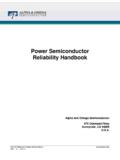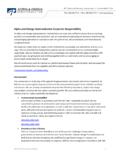Transcription of How to Generate a Negative Voltage Using Buck Converters?
1 August 08 Tel: Fax: 1 How to Generate a Negative Voltage Using Buck Converters? Zach Zhang, Alpha & Omega Semiconductor, Inc. Abstract This article illustrates how to use buck converter to Generate Negative Voltage source. The basic operation theory is introduced, and one practical example is presented. Introduction The Negative Voltage source is widely used in various applications such as computing systems, LCD panels, audio amplifiers, etc. Using the additional secondary winding of a transformer is the widely used approach to Generate the Negative Voltage source for computing systems, but it requires isolation transformer which may not be possible in other applications, and regulation is also bad. The LCD panels usually employs the charge pump to Generate the Negative Voltage due to low cost, but the drawback is obvious: power delivery is limited and regulation is very bad and changes with input Voltage since charge pump can only Generate the integral times input Voltage .
2 In some high-end audio amplifier applications, the text-book method buck boost is applied. The lack of dedicated commercial buck-boost controllers, and the essential control difficulty of buck-boost (right plate zero) prevent the method from being widely used. And thus, designing a high qualify Negative Voltage source is always the challenge in system applications. At the same time, buck converters with internal switches such as EZBucks from Alpha & Omega Semiconductor are quickly gaining popularity. By integrating power MOSFET, controller and even Schottky diode into the same package, the integrated buck converter needs very few external passive components to form a complete DC-DC solution. Since the current-mode control is employed, the compensation is fairly easy; and various protection features such as OCP, OVP, OTP, UVLO, soft-start and short circuit protection and auto-restart have already been built into the chip, the design effort, testing cycle, PCB area and reliability of the DC-DC converter are significantly improved.
3 Thanks to the advanced integration solution, the total BOM cost is also reduced. These integrated buck converters can deliver as much as 10 amps output current, which can meet most emerging requirements of Negative Voltage source. How to Generate a Negative Voltage Using Buck Converter? 1) Buck-boost type converter The classic solution is to configure EZbuck as the buck-boost type converter. Figure 1 shows this configuration. Obviously, an extra error amplifier is needed to Generate the positive feedback Voltage . This error amplifier may not be very cheap because it requires low off-set Voltage and large DC gain. Another issue of this implementation is the internal ESD diode between switching node (LX) and ground. To prevent damage of switching node caused by electrostatic discharge (ESD) during shipping or assembling, an internal ESD diode is connected between switching node and ground.
4 With this ESD diode, when the switching node has large Negative ESD spike, the additional energy can be discharged to the ground of IC and thus avoid the damage of switching node. When the EZBuck is configured as buck type converter, this ESD diode does not function since the switching node switches between Vin and ground. When the EZBuck is configured as buck-boost type, the ESD diode is actually forward biased due to Negative output Voltage and may be damaged by large forward biased current. Application NotePIC-002 August 08 Tel: Fax: 2 RCR/STransconductance AmplifierPWM ComparatorCoutI Sense AmplifierVrefCompensation rampSrampVoutCintVinVCVrampVIsnVfbQ1 CCA1A2 ClockLR1R2-A2 LXESD diode Figure 1: Buck-boost converter to Generate Negative Voltage Using EZBuck 2) Buck type converter Figure 2 shows how to Generate the Negative Voltage bus Using buck type converter.
5 Basically, the IC Using output Voltage as its virtual ground and regulates the system ground to Generate a Negative Voltage . The basic operation is exactly the same as buck converter. The IC monitors the system ground, the Voltage difference between system ground and output Voltage (virtue ground) is amplified and compensated as the control Voltage . At the beginning of each cycle, the PMOS is turned on by clock, the inductor current is charged up by Vin; the inductor current during PMOS turning on is equal to the PMOS current and this information is sensed and amplified to compare with control Voltage . When the current information is larger than control Voltage , PMOS turns-off and waits for the next cycle to turn on. During the PMOS turning off, the current in the inductor free-wheels through the diode. According to the inductor Voltage and second balance, we can obtain Equation 1: TDVoTDVin*)1(** =; Equation 1 Rearrange Equation 1, we can get the relations between input Voltage and output Voltage according to Equation 2.
6 DDVinVo =1* ; Equation 2 This formula is the same as buck-boost converter; but why is it essentially a buck type converter? We can take this circuit in another way: This buck converter steps down a Voltage equal to Vin-Vo ( output Voltage is a virtue ground) to Vo. According to input and output Voltage s relation of buck converter, we can obtain Equation 3. VoDVoVin = *)( Equation 3 Rearrange Equation 3, we can get the relations between input Voltage and output Voltage as the same as Equation 2. Application NotePIC-002 August 08 Tel: Fax: 3 Figure 2: Buck type converter to Generate Negative Voltage Since this circuit is a buck type converter and IC ground (virtual ground) is equal to output Voltage which is the most Negative Voltage , there is no need for additional amplifier to Generate the positive Voltage and there is no potential damage of ESD diode Using buck-boost type converter.
7 Since this is a pure buck type converter operation, the synchronous integrated buck converter can be used as well if the duty cycle is small and the high efficiency is pursued. The following schematic Figure 3 (a) shows a practical example Using AOZ1016 to Generate a -5V power source with the 2A sourcing capability. Figure 3 (b) shows the start-up waveform at -2A resistive load. Figure 3 (a): Schematic of buck-type converter to Generate Negative Voltage Application NotePIC-002 August 08 Tel: Fax: 4 Figure 3 (b): Waveform of buck-type converter to Generate Negative Voltage 1) Vin; 2) The output Voltage ; 4) output current Copyright 2008 Alpha & Omega Semiconductor, Inc. Application NotePIC-002









